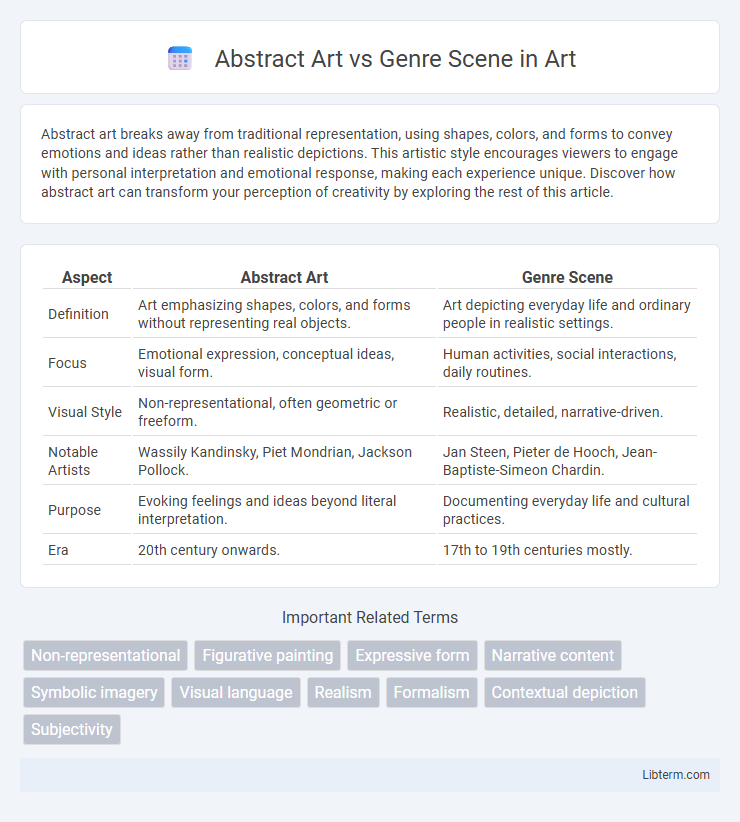Abstract art breaks away from traditional representation, using shapes, colors, and forms to convey emotions and ideas rather than realistic depictions. This artistic style encourages viewers to engage with personal interpretation and emotional response, making each experience unique. Discover how abstract art can transform your perception of creativity by exploring the rest of this article.
Table of Comparison
| Aspect | Abstract Art | Genre Scene |
|---|---|---|
| Definition | Art emphasizing shapes, colors, and forms without representing real objects. | Art depicting everyday life and ordinary people in realistic settings. |
| Focus | Emotional expression, conceptual ideas, visual form. | Human activities, social interactions, daily routines. |
| Visual Style | Non-representational, often geometric or freeform. | Realistic, detailed, narrative-driven. |
| Notable Artists | Wassily Kandinsky, Piet Mondrian, Jackson Pollock. | Jan Steen, Pieter de Hooch, Jean-Baptiste-Simeon Chardin. |
| Purpose | Evoking feelings and ideas beyond literal interpretation. | Documenting everyday life and cultural practices. |
| Era | 20th century onwards. | 17th to 19th centuries mostly. |
Introduction to Abstract Art and Genre Scene
Abstract art emphasizes non-representational forms, colors, and shapes to evoke emotions and ideas without depicting real-world objects. Genre scenes capture everyday life moments, portraying ordinary people engaged in common activities with realistic detail. Both styles offer distinct approaches to visual storytelling, with abstract art prioritizing emotional expression and genre scenes focusing on narrative realism.
Historical Evolution of Both Styles
Abstract art emerged in the early 20th century, driven by pioneers like Wassily Kandinsky and Piet Mondrian who sought to break away from traditional representation by emphasizing shapes, colors, and forms to evoke emotions and concepts. Genre scenes, rooted in the 17th-century Dutch Golden Age with artists such as Johannes Vermeer and Pieter de Hooch, depict everyday life and ordinary people, reflecting social customs and cultural narratives of their time. Over time, abstract art evolved through movements like Cubism and Abstract Expressionism, while genre scenes influenced realism and narrative art, highlighting the different historical trajectories and artistic objectives between the two styles.
Key Characteristics of Abstract Art
Abstract art emphasizes non-representational forms, using shapes, colors, and textures to evoke emotions or concepts rather than depicting recognizable objects. It prioritizes subjective interpretation and often lacks a clear narrative or realistic detail. Key characteristics include the use of geometric or organic shapes, bold color contrasts, and an emphasis on composition and visual harmony over literal representation.
Defining Features of Genre Scene
Genre scenes depict everyday life and ordinary people engaged in common activities, emphasizing narrative detail and social context. These artworks focus on realistic representation and often include domestic interiors, marketplaces, or street scenes. Unlike abstract art, genre scenes prioritize recognizable subjects and storytelling over form and color experimentation.
Influential Artists in Abstract Art
Wassily Kandinsky, often regarded as a pioneer of abstract art, introduced compositions emphasizing color and form without representational content. Kazimir Malevich's Suprematism revolutionized abstraction by focusing on basic geometric shapes and pure artistic feeling. Abstract Expressionists like Jackson Pollock further pushed boundaries by employing dynamic gestural techniques that communicated emotion beyond traditional genre scenes.
Notable Masters of Genre Scene
Notable masters of the genre scene, such as Jean-Baptiste-Simeon Chardin, Pieter de Hooch, and Jan Steen, excelled in depicting everyday life with detailed realism and narrative richness. Their works emphasize domestic interiors, social gatherings, and ordinary activities, capturing the cultural and social nuances of their time. Unlike abstract art, which prioritizes form and color over representational accuracy, genre scene paintings offer a vivid window into historical daily experiences and human interactions.
Techniques and Mediums Used
Abstract art utilizes techniques such as gestural brushstrokes, color field painting, and mixed media to evoke emotions and concepts without representing real-world subjects, often employing mediums like acrylics, oils, and digital tools. In contrast, genre scenes rely on detailed, realistic techniques such as fine brushwork and chiaroscuro to depict everyday life moments, frequently using traditional mediums like oil paint on canvas. The divergent approaches highlight the emphasis on subjective interpretation in abstract art versus narrative clarity in genre scenes.
Emotional Impact and Audience Interpretation
Abstract art emphasizes emotional impact through color, form, and texture, allowing viewers to project personal feelings and interpretations onto non-representational imagery. Genre scenes depict everyday life with recognizable subjects, offering narrative context that guides audience interpretation and elicits empathy for familiar experiences. The emotional engagement in abstract art is subjective and open-ended, while genre scenes evoke shared cultural responses through storytelling and relatable scenarios.
Cultural and Social Contexts
Abstract art emerged in the early 20th century as a response to rapid industrialization and shifting socio-political landscapes, emphasizing emotional expression and the subconscious over representational accuracy. In contrast, genre scenes, rooted in the Dutch Golden Age and beyond, provide detailed depictions of everyday life, reflecting social norms, cultural practices, and class structures of their time. These differing artistic approaches highlight evolving societal values, with abstract art challenging traditional perspectives and genre scenes preserving historical cultural narratives.
Abstract Art vs Genre Scene: Future Perspectives
Abstract art continues to evolve with advancements in digital technology, allowing artists to explore new dimensions of form and color beyond traditional boundaries. Genre scenes, rooted in historical and cultural narratives, are increasingly reinterpreted through contemporary perspectives that challenge social norms and highlight diverse experiences. The future of both abstract art and genre scenes lies in the fusion of innovation and tradition, driven by immersive media and global artistic exchanges that expand audience engagement.
Abstract Art Infographic

 libterm.com
libterm.com